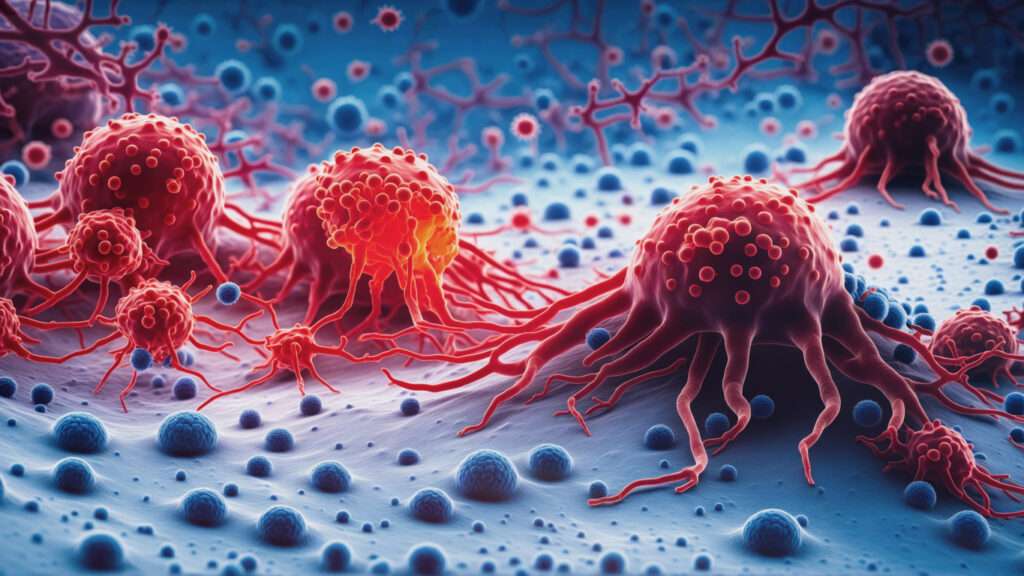A comprehensive new study published in Nature Communications has revealed a significant link between whole-genome duplications (WGDs) in cancer and the higher mortality rates observed among Black patients in the United States.
The research, which analyzed cancer samples from over 1,800 self-reported Black patients, found that tumors from these individuals were significantly more likely to exhibit WGDs—an aggressive genomic alteration—than those from white patients.
The study’s findings highlight the critical role of both genetic and environmental factors in driving racial disparities in cancer outcomes.
“We observed that cancers from self-reported Black patients had a significantly higher incidence of WGDs across multiple cancer types,” the study authors stated. The increased prevalence of WGDs in Black patients, ranging from 11% to 35% higher depending on the dataset, was most prominent in breast, endometrial, and lung cancers. That genetic alteration, which leads to increased metastasis and disease progression, was also associated with shorter survival times, suggesting a potential mechanism for the well-documented racial disparities in cancer mortality.
WGDs are large-scale chromosomal events in which a cell duplicates its entire set of chromosomes. The process creates genomic instability, promoting more aggressive cancer behavior, metastasis, and drug resistance. Tumors with WGDs tend to be harder to treat due to their adaptability. “These duplications allow cancers to ‘sample a wider range of karyotypes,’ making them more capable of resisting treatment and spreading throughout the body,” the study noted.

The findings are particularly concerning given the existing disparities in cancer outcomes between Black and white Americans. Black women, for instance, have a 41% higher mortality rate from breast cancer and a 21% higher mortality rate from endometrial cancer than their white counterparts, even when diagnosed at similar stages of the disease. The study’s authors suggested that the higher frequency of WGDs in Black patients’ tumors may contribute to these disparities. “The increased incidence of WGDs in Black patients may be contributing to racial disparities in cancer outcomes,” the study concluded.
Environmental Exposure and Its Role in WGD Frequency
In addition to genetic factors, the study pointed to environmental exposures as a significant contributor to the higher WGD rates observed in Black cancer patients. The researchers discovered that combustion byproducts, such as those resulting from the burning of fossil fuels, can cause WGD events in cell cultures. “We further demonstrate that combustion byproducts are capable of inducing WGDs in cell culture, and cancers from self-reported Black patients exhibit mutational signatures consistent with exposure to these carcinogens,” the authors said. The study tied the increased frequency of WGDs to carcinogens like polycyclic aromatic hydrocarbons (PAHs), pollutants that are prevalent in urban environments where many Black Americans live.
Due to historical redlining practices and continued economic inequality, Black communities are disproportionately located near industrial areas and high-traffic zones, exposing residents to higher levels of environmental pollutants. “Black individuals are more likely to live in areas with elevated levels of air pollution, including diesel exhaust and other combustion-related pollutants,” the researchers explained, suggesting that these environmental factors may be driving the increased frequency of WGDs in Black patients.

The Genetic Component: TP53 Mutations
The study also explored the genetic factors that might contribute to the higher frequency of WGDs in Black patients, focusing on the tumor suppressor gene TP53. Mutations in this gene, which is inactivated more often in Black patients, were strongly associated with the presence of WGDs. “TP53 mutations have consistently been linked with poor prognosis and aggressive cancer behavior,” the study noted. This gene plays a crucial role in regulating cell division, and its inactivation can lead to uncontrolled cell growth and the spread of cancer.
The presence of TP53 mutations in combination with WGDs creates a hazardous situation for patients, as these tumors are more likely to metastasize and resist treatment. However, the study pointed out that while TP53 mutations were more common in Black patients, they were not the only factor driving the increased frequency of WGDs. Environmental factors, particularly exposure to carcinogens, were likely contributing as well.
Whole-Genome Duplications and Survival Rates
While WGDs were associated with worse outcomes across the board, the study found that Black and white patients with WGD-positive tumors had similar survival rates. “Among patients with WGD-positive tumors, there was no significant difference in survival time between self-reported Black and white patients,” the study reported. However, among patients without WGD-positive tumors, Black patients had significantly shorter survival times than their white counterparts. This suggests that while WGDs play a critical role in cancer progression, other factors—such as socioeconomic status, access to healthcare, and broader environmental exposures—are likely influencing overall survival.
“What this paper hints at is that we’re seeing something which looks like a genetic difference, but the source of that might actually not be genetic—it’s more environmental,” Kanika Arora, a computational biologist at Memorial Sloan Kettering, who was not involved with the study, told STAT, a health, medicine, and life sciences journal. Arora’s observation underscored the complex interplay between genetic predispositions and environmental exposures in determining cancer outcomes.
Underrepresentation of Black Patients in Genomic Studies
The underrepresentation of Black people in genomic research is one significant limitation that the study highlights. Black people made up just 7% of the patients in the datasets analyzed despite comprising 13% of the U.S. population. The underrepresentation limits researchers’ ability to fully understand how genetic and environmental factors influence cancer in Black patients. “The genomic data that we have from people of African ancestry is small, and so we’re not as well powered as we could be to detect these sorts of molecular associations,” said Rameen Beroukhim, a neuro-oncologist at the Dana-Farber Cancer Institute and Harvard Medical School.
The lack of data makes it more challenging to draw definitive conclusions about the impact of environmental exposures, such as specific pollutants, on cancer subtypes in Black patients. Nevertheless, the study’s findings highlight the need for more inclusive research and targeted public health interventions.
Implications for Cancer Treatment and Prevention
Experts agree that the study’s findings could have profound implications for cancer treatment and prevention. “If pollutants are driving disparate cancer rates, cancer treatment and prevention methods need to change accordingly,” Melissa Davis, head of the Institute of Genomic Medicine at Morehouse School of Medicine, told STAT. Davis emphasized the need for a more holistic approach to cancer care—one that addresses not only the genetic and biological factors driving cancer progression but also the environmental conditions that contribute to these disparities.
“We treat patients, we treat their tumor, and then we send them right back into the environment, which we’re saying is causing their cancer, but then we don’t give them any additional information,” Davis said. “If it truly is that exposure that’s driving the cancer, we need to then work with our communities to be more informed, and then drive policies around that.”
The study’s authors echoed these concerns, stressing the importance of reducing environmental carcinogen exposure as a key strategy for addressing cancer disparities. “Targeted prevention strategies and interventions to reduce exposure to environmental carcinogens may offer hope in reducing the incidence of WGDs and, in turn, reducing cancer mortality disparities,” they concluded.
Moving Forward
The study’s findings point to the need for a multi-faceted approach to reducing cancer disparities. While genetic alterations like WGDs are a critical piece of the puzzle, they do not exist in isolation. Environmental exposures, social determinants of health, and access to care all shape cancer outcomes. Future research must focus on these intersections to develop comprehensive strategies for addressing cancer disparities in Black communities.
As Jason Sheltzer, a geneticist at Yale School of Medicine and co-author of the study, put it, “These are not changing the sequence of the gene, they’re changing its dosage in the cell, and this has been recognized to influence cancer in a variety of ways.” The complex interplay of genetic and environmental factors requires equally complex solutions, but with targeted interventions and further research, addressing these disparities is within reach.
By: Stacy M. Brown, NNPA Newswire Senior National Correspondent








